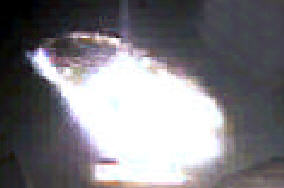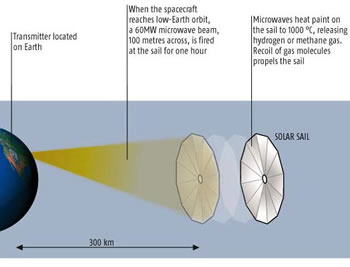Science Fiction
Dictionary
A B C D E F G H I J K L M N O P Q R S T U V W X Y Z
Earth To Mars In A Month With Painted Solar Sail

Gregory Benford, professor of physics at UC Irvine (and noted science fiction author) believes that a spacecraft powered by a special kind of solar sail could reach Mars in just one month.
Dr. Benford and his brother James were testing a very thin carbon-mesh sail, using microwaves as the energy source for propulsion. Unexpectedly, the sail experienced a force considerably greater than predicted. They theorized that the heat from the microwave beam was causing carbon monoxide gas to escape from the sail's surface; the recoil from the escaping molecules provided what could be a useful adjunct to the propulsive force experienced by light sails.
They believe that by beaming microwave energy up from Earth to boil off volatile molecules from a specially formulated paint applied to the sail will provide enough added force to propel a spacecraft to Mars in record time. "It's a different way of thinking about propulsion," Gregory Benford says. "We leave the engine on the ground." Their research will be published this month in the journal Acta Astronautica.

(From Carbon sail lifting against gravity under 5 kW microwave beam illumination.)
This is how it would work: a rocket would take the craft to low-Earth orbit, whereupon the craft would unfurl a 100 meter diameter sail. A transmitter on Earth would fire a one-hour burst of microwaves at it to heat it up, accelerating the craft to 60 kilometres per second. This would set an interplanetary speed record for space probes.

(From At 21,000 Km/hr, Mars is close.)
However, more work is needed to make this possible. The plan would require a 60-megawatt microwave beam with a similar diameter as the sail that was capable of tracking the craft. The deep-space communications network that NASA uses to communicate with Mars rovers and the Cassini probe now orbiting Saturn can only output half a megawatt.
If this design could work, it would make significant progress in the use of ground-based beam-propulsion designs. As science fiction readers know, this topic was explored in the 1974 novel Mote in God's Eye by Larry Niven and Jerry Pournelle. They used the idea of laser cannon from Robert L. Forward's 1961 paper Ground-Based Lasers For Propulsion In Space to bring an alien spacecraft to our solar system. Readers may also wish to explore early sf looks at solar sails.
Read a bit more about Gregory Benford; the article First Flight By A Laser-Powered Airplane chronicles an earlier effort at ground-based propulsion. See also Solar super-sail could reach Mars in a month and Acceleration of Sails by Thermal Desorption of Coatings (pdf).
Scroll down for more stories in the same category. (Story submitted 2/9/2005)
Follow this kind of news @Technovelgy.| Email | RSS | Blog It | Stumble | del.icio.us | Digg | Reddit |
Would
you like to contribute a story tip?
It's easy:
Get the URL of the story, and the related sf author, and add
it here.
Comment/Join discussion ( 9 )
Related News Stories - (" Space Tech ")
Will Space Stations Have Large Interior Spaces Again?
'They filed clumsily into the battleroom, like children in a swimming pool for the first time, clinging to the handholds along the side.' - Orson Scott Card, 1985.
Reflect Orbital Offers 'Sunlight on Demand' And Light Pollution
'I don't have to tell you about the seven two-mile-diameter orbital mirrors...'
Chrysalis Generation Ship to Alpha Centauri
'This was their world, their planet —
this swift-traveling, yet seemingly moveless vessel.' - Nat Schachner, 1934
The First Space Warship For Space Force
'Each of the electrical ships carried about twenty men...' - Garrett P. Serviss, 1898.
Technovelgy (that's tech-novel-gee!) is devoted to the creative science inventions and ideas of sf authors. Look for the Invention Category that interests you, the Glossary, the Invention Timeline, or see what's New.
Science Fiction
Timeline
1600-1899
1900-1939
1940's 1950's
1960's 1970's
1980's 1990's
2000's 2010's
Current News
Natural Gait With Prosthetic Connected To Nervous System
'The leg was to function, in a way, as a servo-mechanism operated by Larry’s brain...'
Woman Marries Computer, Vonnegut's Dream Comes True
'Men are made of protoplasm... Lasts forever.'
Spidery 'Walk Me' Toyota Autonomous Wheel Chair Like Star Wars
Walk along with the emperor.
Dancing Robots Taught Dance Moves
'A clockwork figure would be the thing for you...'
Proof Of Robothood - Not A Person
'Who are you people? - Show 'em.'
Indonesian Clans Battle
'The observation vehicle was of that peculiar variety used in conveying a large number of people across rough terrain.'
The 'Last Mile' In China Crowded With Delivery Robots
Yes, it's a delivery robot. On wheels.
Tornyol Microdrone Kills Mosquitoes
'The real border was defended by... a swarm of quasi-independent aerostats.'
PLATO Spacecraft, Hunter Of Habitable Planets, Now Ready
'I ... set my automatic astronomical instruments to searching for a habitable planet.'
Factory Humanoid Robots Built By Humanoid Robots
'...haven't you a section of the factory where only robot labor is employed?'
iPhone Air Fulfils Jobs' Promise From 2007 - A Giant Screen!
'... oblongs were all over the floor and surfaces.'
ChatGPT Now Participates in Group Chats
'...the city was their laboratory in human psychology.'
iPhone Pocket All Sold Out!
'A long, strong, slender net...'
Did The Yautja Have These First?
What a marvel of ingenuity the little device was!
Jetson ONE Air Races Begin, Can Air Polo Be Far Behind?
'If you're one of those rarities who haven't attended a rocket-polo "carnage", let me tell you it's a colorful affair.'
Will Space Stations Have Large Interior Spaces Again?
'They filed clumsily into the battleroom, like children in a swimming pool for the first time, clinging to the handholds along the side.'
